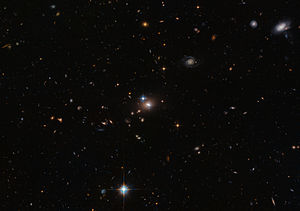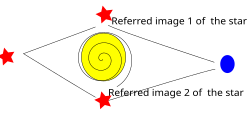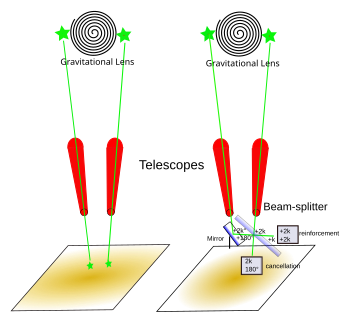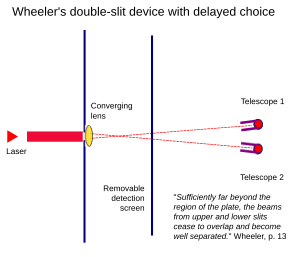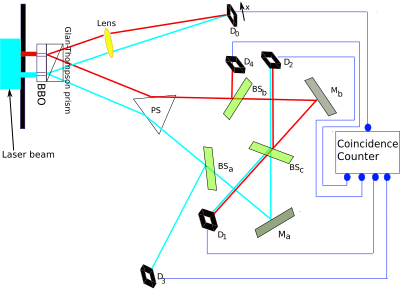The Wheeler–Feynman absorber theory (also called the Wheeler–Feynman time-symmetric theory), named after its originators, the physicists Richard Feynman and John Archibald Wheeler, is an interpretation of electrodynamics derived from the assumption that the solutions of the electromagnetic field equations must be invariant under time-reversal transformation, as are the field equations themselves. Indeed, there is no apparent reason for the time-reversal symmetry breaking, which singles out a preferential time direction and thus makes a distinction between past and future. A time-reversal invariant theory is more logical and elegant. Another key principle, resulting from this interpretation and reminiscent of Mach's principle due to Tetrode, is that elementary particles are not self-interacting. This immediately removes the problem of self-energies.
T-symmetry and causality
The requirement of time-reversal symmetry, in general, is difficult to conjugate with the principle of causality. Maxwell's equations and the equations for electromagnetic waves have, in general, two possible solutions: a retarded (delayed) solution and an advanced one. Accordingly, any charged particle generates waves, say at time and point
and point  , which will arrive at point
, which will arrive at point  at the instant
at the instant  (here
(here  is the speed of light), after the emission (retarded solution), and
other waves, which will arrive at the same place at the instant
is the speed of light), after the emission (retarded solution), and
other waves, which will arrive at the same place at the instant  , before the emission (advanced solution). The latter, however, violates the causality principle: advanced waves
could be detected before their emission. Thus the advanced solutions
are usually discarded in the interpretation of electromagnetic waves. In
the absorber theory, instead charged particles are considered as both
emitters and absorbers, and the emission process is connected with the
absorption process as follows: Both the retarded waves from emitter to
absorber and the advanced waves from absorber to emitter are considered.
The sum of the two, however, results in causal waves, although the anti-causal (advanced) solutions are not discarded a priori.
, before the emission (advanced solution). The latter, however, violates the causality principle: advanced waves
could be detected before their emission. Thus the advanced solutions
are usually discarded in the interpretation of electromagnetic waves. In
the absorber theory, instead charged particles are considered as both
emitters and absorbers, and the emission process is connected with the
absorption process as follows: Both the retarded waves from emitter to
absorber and the advanced waves from absorber to emitter are considered.
The sum of the two, however, results in causal waves, although the anti-causal (advanced) solutions are not discarded a priori.Feynman and Wheeler obtained this result in a very simple and elegant way. They considered all the charged particles (emitters) present in our universe and assumed all of them to generate time-reversal symmetric waves. The resulting field is
 , being a solution of the homogeneous Maxwell equation, can be used to obtain the total field
, being a solution of the homogeneous Maxwell equation, can be used to obtain the total fieldThe assumption that the free field is identically zero is the core of the absorber idea. It means that the radiation emitted by each particle is completely absorbed by all other particles present in the universe. To better understand this point, it may be useful to consider how the absorption mechanism works in common materials. At the microscopic scale, it results from the sum of the incoming electromagnetic wave and the waves generated from the electrons of the material, which react to the external perturbation. If the incoming wave is absorbed, the result is a zero outgoing field. In the absorber theory the same concept is used, however, in presence of both retarded and advanced waves.
The resulting wave appears to have a preferred time direction, because it respects causality. However, this is only an illusion. Indeed, it is always possible to reverse the time direction by simply exchanging the labels emitter and absorber. Thus, the apparently preferred time direction results from the arbitrary labelling.
T-symmetry and self-interaction
One of the major results of the absorber theory is the elegant and clear interpretation of the electromagnetic radiation process. A charged particle that experiences acceleration is known to emit electromagnetic waves, i.e., to lose energy. Thus, the Newtonian equation for the particle ( )
must contain a dissipative force (damping term), which takes into
account this energy loss. In the causal interpretation of
electromagnetism, Lorentz and Abraham proposed that such a force, later called Abraham–Lorentz force,
is due to the retarded self-interaction of the particle with its own
field. This first interpretation, however, is not completely
satisfactory, as it leads to divergences in the theory and needs some
assumptions on the structure of charge distribution of the particle. Dirac
generalized the formula to make it relativistically invariant. While
doing so, he also suggested a different interpretation. He showed that
the damping term can be expressed in terms of a free field acting on the
particle at its own position:
)
must contain a dissipative force (damping term), which takes into
account this energy loss. In the causal interpretation of
electromagnetism, Lorentz and Abraham proposed that such a force, later called Abraham–Lorentz force,
is due to the retarded self-interaction of the particle with its own
field. This first interpretation, however, is not completely
satisfactory, as it leads to divergences in the theory and needs some
assumptions on the structure of charge distribution of the particle. Dirac
generalized the formula to make it relativistically invariant. While
doing so, he also suggested a different interpretation. He showed that
the damping term can be expressed in terms of a free field acting on the
particle at its own position:A clear and simple explanation can instead be obtained in the framework of absorber theory, starting from the simple idea that each particle does not interact with itself. This is actually the opposite of the first Abraham–Lorentz proposal. The field acting on the particle
 at its own position (the point
at its own position (the point  ) is then
) is thenCriticism
The Abraham–Lorentz force is, however, not free of problems. Written in the non-relativistic limit, it givesOther difficulties may arise trying to solve the equation of motion for a charged particle in the presence of this damping force. It is commonly stated that the Maxwell equations are classical and cannot correctly account for microscopic phenomena, such as the behavior of a point-like particle, where quantum-mechanical effects should appear. Nevertheless, with absorber theory, Wheeler and Feynman were able to create a coherent classical approach to the problem (see also the "paradoxes" section in the Abraham–Lorentz force).
Also, the time-symmetric interpretation of the electromagnetic waves appears to be in contrast with the experimental evidence that time flows in a given direction and, thus, that the T-symmetry is broken in our world. It is commonly believed, however, that this symmetry breaking appears only in the thermodynamical limit (see, for example, the arrow of time). Wheeler himself accepted that the expansion of the universe is not time-symmetric in the thermodynamic limit. This, however, does not imply that the T-symmetry must be broken also at the microscopic level.
Finally, the main drawback of the theory turned out to be the result that particles are not self-interacting. Indeed, as demonstrated by Hans Bethe, the Lamb shift necessitated a self-energy term to be explained. Feynman and Bethe had an intense discussion over that issue, and eventually Feynman himself stated that self-interaction is needed to correctly account for this effect[1].
Developments since original formulation
Gravity theory
Inspired by the Machian nature of the Wheeler–Feynman absorber theory for electrodynamics, Fred Hoyle and Jayant Narlikar proposed their own theory of gravity[2][3][4] in the context of general relativity. This model still exists in spite of recent astronomical observations that have challenged the theory.[5] Stephen Hawking had criticized the original Hoyle-Narlikar theory believing that the advanced waves going off to infinity would lead to a divergence, as indeed they would, if the universe were only expanding. However, as emphasized in the revised version of the Hoyle-Narlikar theory devoid of the "Creation Field" (generating matter out of empty space) known as the Gravitational absorber theory, the universe is also accelerating in that expansion. The acceleration leads to a horizon type cutoff and hence no divergence[6]. Gravitational absorber theory has been used to explain the mass fluctuations in the Woodward effect (see section on Woodward effect below).Transactional interpretation of quantum mechanics
Again inspired by the Wheeler–Feynman absorber theory, the transactional interpretation of quantum mechanics (TIQM) first proposed in 1986 by John G. Cramer,[7][8] describes quantum interactions in terms of a standing wave formed by retarded (forward-in-time) and advanced (backward-in-time) waves. Cramer claims it avoids the philosophical problems with the Copenhagen interpretation and the role of the observer, and resolves various quantum paradoxes, such as quantum nonlocality, quantum entanglement and retrocausality.[9][10]Shu-Yuan Chu's quantum theory in the presence of gravity
In 1993, Chu developed a model of how to do quantum mechanics in the presence of gravity, which combines some of the latest ideas in particle physics, superstrings, and a time-symmetric Wheeler–Feynman description of gravity and inertia.[11][12] In 1998 he extended this work to derive Einstein's equation for the "adjunct gravitational field" using concepts from statistics and maximizing the entropy.[13]Attempted resolution of causality
T. C. Scott and R. A. Moore demonstrated that the apparent acausality suggested by the presence of advanced Liénard–Wiechert potentials could be removed by recasting the theory in terms of retarded potentials only, without the complications of the absorber idea.[14][15] The Lagrangian describing a particle ( ) under the influence of the time-symmetric potential generated by another particle (
) under the influence of the time-symmetric potential generated by another particle ( ) is
) is is the relativistic kinetic energy functional of particle
is the relativistic kinetic energy functional of particle  , and
, and  and
and  are respectively the retarded and advanced Liénard–Wiechert potentials acting on particle
are respectively the retarded and advanced Liénard–Wiechert potentials acting on particle  and generated by particle
and generated by particle  . The corresponding Lagrangian for particle
. The corresponding Lagrangian for particle  is
is with
with  . For
. For  this Lagrangian will generate exactly the same equations of motion of
this Lagrangian will generate exactly the same equations of motion of  and
and  . Therefore, from the point of view of an outside
observer, everything is causal. This formulation reflects
particle-particle symmetry with the variational principle applied to the
N-particle system as a whole, and thus Tetrode's Machian principle[17].
Only if we isolate the forces acting on a particular body do the
advanced potentials make their appearance. This recasting of the problem
comes at a price: the N-body Lagrangian depends on all the time
derivatives of the curves traced by all particles, i.e. the Lagrangian
is infinite-order. However, much progress was made in examining the
unresolved issue of quantizing the theory.[18][19][20] Also, this formulation recovers the Darwin Lagrangian, from which the Breit equation was originally derived, but without the dissipative terms.[17] This ensures agreement with theory and experiment, up to but not including the Lamb shift. Numerical solutions for the classical problem were also found.[21] Furthermore, Moore showed that a model by Feynman and Hibbs is amenable to the methods of higher than first-order Lagrangians and revealed chaoticlike solutions.[22] Moore and Scott[14]
showed that the radiation reaction can be alternatively derived using
the notion that, on average, the net dipole moment is zero for a
collection of charged particles, thereby avoiding the complications of
the absorber theory. An important bonus from their approach is the
formulation of a total preserved canonical generalized momentum, as
presented in a comprehensive review article in the light of quantum nonlocality.[23]
. Therefore, from the point of view of an outside
observer, everything is causal. This formulation reflects
particle-particle symmetry with the variational principle applied to the
N-particle system as a whole, and thus Tetrode's Machian principle[17].
Only if we isolate the forces acting on a particular body do the
advanced potentials make their appearance. This recasting of the problem
comes at a price: the N-body Lagrangian depends on all the time
derivatives of the curves traced by all particles, i.e. the Lagrangian
is infinite-order. However, much progress was made in examining the
unresolved issue of quantizing the theory.[18][19][20] Also, this formulation recovers the Darwin Lagrangian, from which the Breit equation was originally derived, but without the dissipative terms.[17] This ensures agreement with theory and experiment, up to but not including the Lamb shift. Numerical solutions for the classical problem were also found.[21] Furthermore, Moore showed that a model by Feynman and Hibbs is amenable to the methods of higher than first-order Lagrangians and revealed chaoticlike solutions.[22] Moore and Scott[14]
showed that the radiation reaction can be alternatively derived using
the notion that, on average, the net dipole moment is zero for a
collection of charged particles, thereby avoiding the complications of
the absorber theory. An important bonus from their approach is the
formulation of a total preserved canonical generalized momentum, as
presented in a comprehensive review article in the light of quantum nonlocality.[23]This apparent acausality may be viewed as merely apparent, and this entire problem goes away. An opposing view was held by Einstein.[24]
Alternative Lamb shift calculation
As mentioned previously, a serious criticism against the absorber theory is that its Machian assumption that point particles do not act on themselves does not allow (infinite) self-energies and consequently an explanation for the Lamb shift according to quantum electrodynamics (QED). Ed Jaynes proposed an alternate model where the Lamb-like shift is due instead to the interaction with other particles very much along the same notions of the Wheeler–Feynman absorber theory itself. One simple model is to calculate the motion of an oscillator coupled directly with many other oscillators. Jaynes has shown that it is easy to get both spontaneous emission and Lamb shift behavior in classical mechanics.[25] Furthermore, Jayne's alternatives provides a solution to the process of "addition and subtraction of infinities" associated with renormalization.[23][26]This model leads to essentially the same type of Bethe logarithm an essential part of the Lamb shift calculation vindicating Jaynes' claim that two different physical models can be mathematically isomorphic to each other and therefore yield the same results, a point also apparently made by Scott and Moore on the issue of causality.
Woodward effect
The Woodward effect[27] is a physical hypothesis about the possibility for a body to see its mass change when the energy density varies in time. Proposed in 1990 by James Woodward, the effect is based on a formulation of Mach's principle proposed in 1953 by Dennis Sciama.[28]If confirmed experimentally (see timeline of results in the main article), the Woodward effect would open pathways in astronautics research, as it could be used to propel a spacecraft by propellantless propulsion meaning that it would not have to expel matter to accelerate. As previously formulated by Sciama, Woodward suggests that the Wheeler–Feynman absorber theory would be the correct way to understand the action of instantaneous inertial forces in Machian terms.[29]












